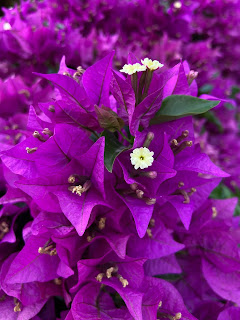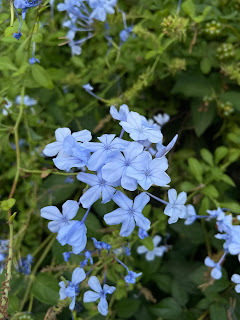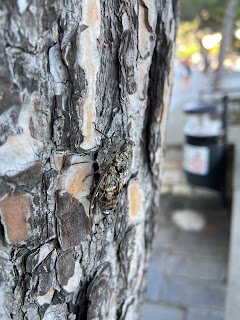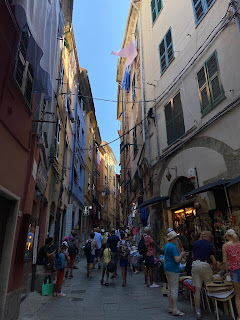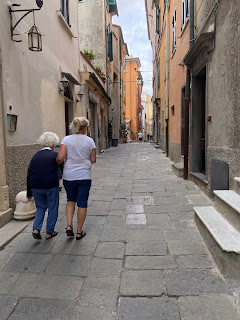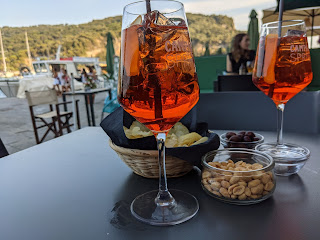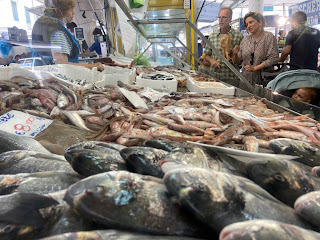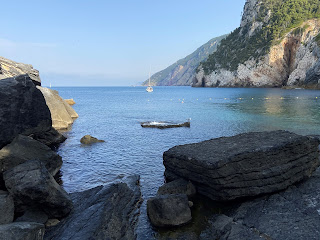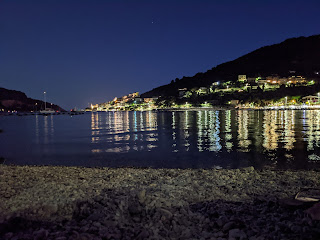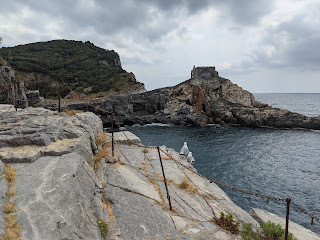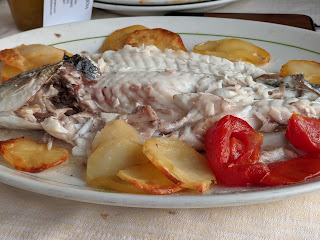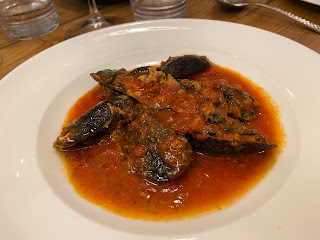



Top row: Porto Venere Italy in the morning. Grotta Byron and the Church of San Pietro. View from the Church of San Lorenzo toward the Gulf of La Spezia.
Bottom Row: Porto Venere at night from the water. View from Locanda Lorena toward Porto Venere and Monte Muzzerone. View of the Church of San Pietro and Grotta Byron at night, Porto Venere.
Intro
Lunigiana
Everyone in northern Italy knows that Cisa is the nickname of the highway connecting Parma to La Spezia. At the time of our friend's text message, we are still near Brescia, so not even close to the start of Cisa! Oops, I lied.
The Cisa takes is named for the pass that is the highest point along the way, Cisa Pass. The highway is officially called L'autostrada A15 Autocamionale della Cisa. The pass is on the border between northern Tuscany (Province of Massa-Carrara) and Emilia-Romagna (Province of Parma), at an altitude of 1,040 meters (3,414 feet) above sea level. The start of the construction of the Cisa dates to the 1950s. The highway was designed to provide an alternative route between the Po Valley and the coastal Tyrrhenian Sea. This winding autostrada challenges drivers and passengers.
Going north to south, the Cisa starts in Emilia-Romagna, passes into Tuscany, and then ends in Liguria. In the Tuscan section of the highway, we stop at Pontremoli for lunch at Antica Trattoria Pelliccia, an Osteria d'Italia guide book pick. (The Osteria d'Italia app on your phone is the way to go if you are traveling around Italy and is worth every penny.)
At Trattoria Pelliccia, we try the local dish called testaroli. This dish is a pasta that seems more like a bread, based on flour, salt, and water. Testaroli are cooked on a flat terra cotta or cast iron cooking surface called a testo. The cooked pasta is sliced into triangular shapes and served with a sauce, like pesto. It is said that testaroli is an ancient pasta originating from the Etruscan civilization of Italy.
Pontremoli is a small city with a rich story reaching back to the 1000 BC. It is at the very northern tip of Tuscany, at the foot of the Apennines, along the Via Francigena. The Francigena is an old pilgrimage route starting in Canterbury England, passing through France and Switzerland, through Pontremoli, to Rome, and then on to Puglia, where pilgrims would embark for the Holy Land.


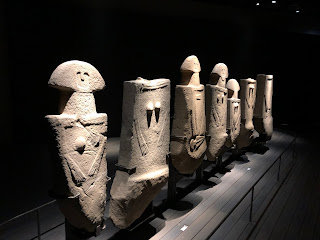




Pontremoli is part of what was once a territory called Lunigana. The territory name derives from ancient Roman city of Luna, long ago abandoned and now an archeological site. But the most striking artifacts of the Lunigana territory are the anthropomorphic stele that are found in large numbers and that predate the Romans. These prehistoric sandstone statue stele date from between 4,000 and 1,000 BC and depict male and female figures, many with faces, arms, jewelry, clothes, and weapons sculpted in low relief.
The function of these stele is still not exactly known. Some were certainly used as burial monuments, while other were used as way markers. Nearly all the stele statues were found casually during the digging of ditches or building roads during the beginning in the XIX century.
The castle of the Piagnaro in Pontremoli was an important center for the Lunigiani and today houses an impressive collection of these stele called Pontremoli Museo Statue Stele A.C. Ambrosi. Lunch and a look at the collection in the castle makes for a good half day in Pontremoli.
After lunch, we visit the castle and walk on a piece of the Via Francigena. Our pilgrimage is short today because the beach awaits us. These wannabe pilgrims jump back on the Cisa (A15) and under an hour later are cruising the lungomare of La Spezia.
Lungomare
Porto Venere can be spelled either as one word or two words. Both forms are acceptable, and we'll use the two word form commonly used in Italy. The name Porto Venere comes from the ancient Latin name for the town Veneris Portus, which they believe is due to a temple dedicated to Venus which stood where today stands the church of San Pietro. In 1997, Porto Venere and the villages of Cinque Terre were designated by UNESCO as a World Heritage Site.
After the passing through the waterfront of La Spezia, it's only another 20 minutes to reach Porto Venere, where we check into our vacation house for the week. We are seven with two others to join us later in the week. By the time we unpack, and everyone selects a room, it's 4 pm and time to take our first dip in the Mediterranean. We choose the calm water of a "free" beach in front of our rental house, Spiaggia Libera delle Terrazze. Ironically, it will be the only time during our week stay that we'll swim in the afternoon. For the rest of our time in Porto Venere, we'll swim in the morning.
We are curious beachgoers. Most beachgoers are on the beach generally between 10 am to 5 pm. We on the other hand have a different rhythm: 8 – 10 am: swim, breakfast; 10 am – 5 pm: find shade, lunch, lounge; 5 – 7 pm: groceries, sightseeing, walk, 7 – 9 pm: dinner. It will take a day or two for us to get into our rhythm, but we do.
Our rhythm is driven by the fact that we don't care to lay out in the sun. (Tanning in Italian culture is highly valued as a pursuit as discussed in Abbronzatissima: Notes on the Allure of the Suntan in Italy.) In seaside spots like Porto Venere, swimming in the morning or early evening works out well because you'll generally find less people on the beaches and in the water, and the sun is not as strong.
While we are not focused on sun tanning and generally sitting on the beach, we do see a great deal of Porto Venere beaches by walking the lungomare. A lungomare is a "strada lungo la riva del mare" a long street along the water with spacious areas to walk and enjoy the view. Porto Venere's lungomare runs approximately north south. Our vacation house is at the north end of the lungomare and the center of Porto Vernere is at the south end, one kilometer away. We naturally find ourselves on the lungomare a couple of times a day, getting a good look at the beaches. We pass Spiaggia Libera delle Terrazze, Sporting Beach, Spiaggia dell'Olivo, and Spiaggia di Arenella, not to mention the numerous unnamed spots with just boulders but that are equally popular.
What are these beaches like? The word beach must be qualified when talking about Porto Venere. Banish wide, white, pristine stretches of sand from your mind. Think instead pebbly shores, big breakwater boulders, and cemented areas. Every usable piece of land near the water becomes a beach. People get creative where they put their towels. We saw people perched in contorted positions on boulders for hours. We saw people stretched on out concrete piers or claiming areas you wouldn't say would be fit for hanging out at all day. Such is the desire to find one's own space. (Our solution was to swim in the morning and only in Grotta Byron as we'll discuss later.)
Some beaches are free, and others are private (stabilimenti balneari). Private beaches come with services like Wi-Fi, bar services, and toilets. In these private beaches, you rent a chair, umbrella, and table and park yourself for the day. These stabilimenti can be quite nice especially if you want a few amenities. Costs vary but are generally under 20 euros for the day for something basic.
Who's here in Porto Venere? From what we can tell, it's mostly Italians and some Northern Europeans in late July. On our drive down on the Cisa, we saw license plates from the north, mostly Germany, France, and Netherlands. Walking around Porto Venere and eavesdropping on conversations, confirms it.
What's the average beachgoer look like? The crowd is a mix of everything. Ages range from very young to ancient. Body types go from super fit to beached whale. The mix of skin colors runs the gamut from crispy brown to milk white. We see hotties and not-so-hotties. Refreshingly, I don’t feel out of place with my fluorescent white legs and my dated Sergio Tacchini swimsuit (which I didn't feel the least bit guilty using as shorts), as we do our lungomare promenade.
Cozze e cicale
One of the first things you notice upon entering the Gulf of La Spezia are grids of poles and buoys. Even looking at satellite imagery before arriving, we were curious as to what these structures were.
It’s not much of a mystery after a bit of research. It's mussel growing, mitilicoltura in Italian, and it's an ancient and important industry in this gulf.
The networks of buoys and poles are nurseries (vivaio) with precise rules for their layout. Poles and buoys are 5 meters apart. Poles must stick above the water for 1.5 meters. Each nursery can be no more than 1500 sqm (16000 sqft). Nurseries with black buoys are a newer style of nursery while nurseries with poles are the traditional style of farming. Each has its advantages and disadvantages.
Buoy or boa in Italian becomes boe in the plural. Talking with a friend, we said there were a lot of bue floating in the water instead of boe – because it was the only word we could think of. She chuckled. Bue means ox or bull and the sight of oxen floating in the water would be a funny sight.
Ever the trust-and-verify types, one day we swim out to check out these watery nurseries to confirm that they are really mussels under water. And lo and behold, we see suspended bags of mussels through our fogged swim masks and get a firsthand look at la mitilicoltura spezzina.
In Italian, mussels are called cozze; locally in La Spezia, they are called muscoli. The first half of the word mitilicoltura derives from the word mitilo, another way to say mussel and itself probably derived from the genus name Mytilus, for Mediterranean mussels (Mytilus galloprovincialis).
While mussels tickle our culinary palate during this vacation, cicadas assault our ears. Cicadas (cicale) are the soundtrack of the week. On our kilometer lungomare walk from house to Porto Venere center, the cicadas are deafening. They seem to be everywhere and nowhere at the same time. You must look carefully to spot them. Many species described as cryptic, hard to see in layman’s terms. Confirmed. The cicadas we manage to find on pine trees look just like the bark.
We manage to photograph a few cicadas and to the best of our entomological skills, we believe we are hearing and seeing Cicada orni, one of the most common cicadas in southern and central Europe. (Listen to this cicada's sound here.) The cicadas we hear and see are in the same family as the periodic cicadas, specifically the 13-year and 17-year periodical cicadas of eastern North America. Find out more about cicadas at Cicada Mania.
In our lungomare promenade we’ve so far described beaches, people, mussels, and cicadas. Colorfully dressed African men selling beach essentials complete the spectacle. Their pop-up stores go up around 9 am each day. They create neat rows of sunglasses, hammam beach blankets, and colorful African-print bucket hats. Ever the diviners of market demand, one morning when there are a few drops of rain, they adjust their inventory to include umbrellas.
Judging by the number of people we see laying on the blankets and wearing the hats they sell, business is good. Their sales tactics are smooth as we found out firsthand when we compliment one seller on his colorful matching pants and shirt he's wearing. He is immediately ready to sell them off his back or anything else to us. We decline politely, but his words and compliments might make us a buyer if we don't keep moving.
Gulf of Poets
La Spezia sits at the north end of horseshoe-shaped gulf called the Golfo della Spezia. Porto Venere is on the west side of the gulf. The gulf is protected by a diga foranea – a 2.2 km breakwater – that can be seen in some of the photos in this post. You can also clearly see the breakwater in satellite imagery as well as the shellfish farming (mussels and clams) on both sides of the breakwater.
This gulf also has the nickname Golfo dei poeti (Gulf of the Poets). Many poets, artists, writers, and intellectuals – and not just Italian – have written about the gulf, called it home, or spend time here. The one person that occupies our mind during our week stay is the English poet and politician Lord Byron (1788 – 1824). We swim in the grotto named after him, Grotta Byron. Going to the grotto every morning during our stay in Porto Venere becomes our quasi-spiritual ritual, our way to find a little peace and solitude away from the lungomare crowds.
As you approach the Church of San Pietro, walking south from the Porto Venere city center, a doorway in an old defense wall opens to the Grotta Byron. Over the doorway an inscription in Italian and English reads: "Questa grotta inspiratrice di Lord Byron ricorda l'immortale poeta che ardito nuotare sfido le onde del mare da Porto Venere a Lerici." "This grotto was the inspiration of Lord Byron. It records the immortal poet who as a daring swimmer defied the waves of the sea from Porto Venere to Lerici."
Lerici, on the east side of the Gulf of Poets, was the temporary home of Lord Byron's friend and fellow countryman, Percy Bysshe Shelley (1792 – 1822). The inscription seems to imply that Bryon swam from Porto Venere to Lerici, about 8 kilometers. Alas, this seems to be a false but enduring story.
The Church of San Pietro, striped in black and white stone, sits at a rocky point at the southernmost point of Porto Venere and keeping watch over the Grotta Byron. Tourists are drawn to the church's scenic position, with sheer drops to the Mediterranean on three sides. The rocky outcrop is where a statue to Venus (Venere) is said to once stood giving Porto Venere its name. As precious as space is on the rocky outcrop, there is space for a dirt soccer field at the base of the church, silent during the heat of the day but alive at night.
We descend through the doorway, under the inscription, and make our way down the steep marble stairs that finish onto marble cliffs. Nobody is there in the morning. The gulls lament and sound like cranky people, and a lone cormorant flaps its wings to dry them or scare us.
We find a boulder to hide our backpack behind and study the sea fennel (Crithmum maritimum) growing out of the crevices of the black marble. Sea fennel is also known by the curious name rock samphire and is an edible plant. We break off a few leaves and taste them after one morning's swim. The taste is slight bitter, salty, and vaguely fennel-like. How would this work with mussels?
The cliffs surrounding Grotta Byron look like the tortured pages of a book viewed sideways. What stories these marble cliffs could tell. A bronze statue by Raffaele "Lello" Scorzelli called Mater Naturae (1989) sits on the cliff above watching the sea as if she's waiting for someone to return and tell their story. A plaque in the grotto commemorates the life of Alberto "Nasello" Viti (1930 – 1985). Viti loved the grotto and was known for his spectacular dives from the cliffs. The black and white photo on the plaque tells the story: Viti swan diving into the grotto with onlookers.
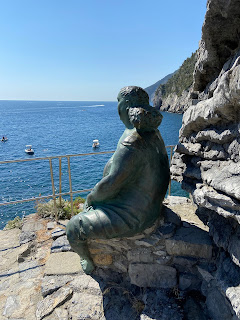

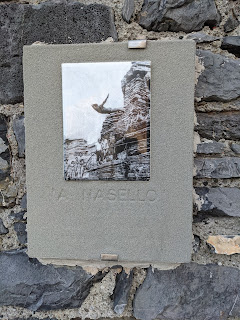




In the Grotta Byron, we swim out past the buoy-line that is meant to keep boats from anchoring too close. The buoys serve no purpose in the morning as boats only come in the afternoon. We swim far enough out to catch a glimpse of the top of San Pietro. We go still farther, under Castello Doria and the cemetery, only 40 meters over our heads but seeming so much higher. To Viti and a friend, the distance was nothing as they once dove from the behind the cemetery into the grotto.
One morning while floating in the grotto, out past the buoys, we see a funeral procession walking the rim of the grotto from San Pietro to the cemetery. A coffin rides atop the people. A few of the mourners stop to investigate the grotto. We imagine they are jealous of us swimming on an already muggy morning. It's 8 am.
Moving our gaze from the procession back out to open water, we see an empty cruise ship that has been anchored in the same spot for who knows how long – metaphorically dead. No cargo of holiday makers, no endless buffets, no ports to visit. The Costa Diadema cruise ship, a big C on its funnel, sits idle and useless, waiting for the pandemic to end.
RNM
For the first couple of days of our stay in Porto Venere, our trips are up and down the lungomare. On the fourth morning, we decide to break free of our part of the Gulf of Poets (called Seno dell'Olivo) and see what’s over the hill in the next bays (Seno delle Grazie and Seno del Varignano). Our objective is a visit to the Varignano Roman Villa.
It feels like we are going a big adventure, but in terms of hiking, it's not much, just a few kilometers roundtrip. Undeterred by the withering heat (and it's only 9 am), we start climbing – up stone steps used by the locals – to reach the crest of the ridge separating the bays. We are alone; everyone else is sleeping or already at the beach.
Fifteen minutes later, we arrive at the entrance gate of the villa and it's locked. An inauspicious sign. We ring the bell and find out that the door is stuck, and we'll need to go around to another door. The paths around the villa are steep and narrow and full of passion fruit we happily sample.

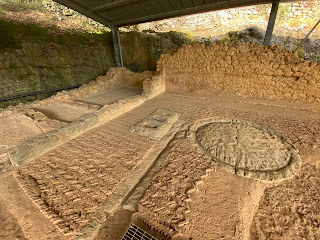






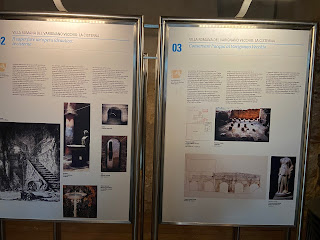



The Varignano Roman Villa was an ancient Roman residence-farm in today's town of Le Grazie (Porto Venere). Today the site is a museum that can be visited. Construction on the villa dates to the 1st century BC. The villa produced olive oil and stored fresh water for sale. Signs of oil pressing and storage are still visible today. At one time, the bay (Seno del Varignano) came right to the villa's edge and ships could pull up to pick up their oil and water. The villa changed from producing olive oil to farming in the second half of the 1st century AD. And, finally the villa was abandoned with the rising level of the sea in the beginning of the 5th century AD.
The villa has just a few other visitors during our hour there. A man in the guardroom/control center on the hill above the villa gives us the quick and dirty overview of the villa, pointing out features through an open window. We step outside, and an art student working at the site fills in the details over the next 30 minutes. She seems happy to have an interested audience, and we pepper her with questions.










After our visit to the Roman Villa, we stop by a cemetery on our way down into Le Grazie for a coffee. We strike up a conversation with the caretaker and get the inside scoop on the management of cemeteries with limited space, which is typical all over Italy and especially in Liguria. The cycle is generally this:
- tumulazione – burial in loculo – recess, cripta – tomb, or cappella – chapel.
- scandenza concessione – expiration of burial concession after some years – because of no payment or other reason.
- esumazione – remains exhumed, with the following options:
- estumulazione – remains go back into another loculo, cripta or cappella – someone paid the bill.
- inumazione – remains go in the ground to finish skeletonization if needed and then into common ossuary
- cremazione – cremation
That brings us to the curious acronym we saw on some graves: RNM. The caretaker explains it to us. The acronym means that exhumed remains weren't entirely yet skeletonized and needed to go in the ground to finish decomposing. RNM stands for resti non mineralizzati, remains not mineralized.
One day in Porto Venere, we wander into the cemetery that looks down on the Grotta Byron. The cemetery is compact. Like the cemetery in Le Grazie, space is at a premium in hilly areas like Liguria. There is a sign on the entrance that lists the names of burial plots (loculo, cripta, cappella) that have expired (avviso di scadenza concessione cimiteriale). If the plots are not paid for, the remains will be exhumed and put in a communal ossuary to free up space. Now we know if the remains exhumed aren't completely mineralized, they might spend some more "curing" time in the ground. That could explain some of the fresh mounds we see in the open space of the cemetery.
The Porto Venere cemetery is the resting place of the Italian mountain climber, explorer, and journalist Walter Bonatti (1930 – 2011). Looking past the black marble cross at the head of his tombstone, the Costa cruise ship is still there and still empty. (That damn ship keeps appearing in many of our photos this week.)
Adaptation
The Costa Fascinosa, Costa Magica, and Costa Diadema are ghost ships we see offshore and in the Gulf of Poets during our week in Porto Venere. These Costa cruise ships are examples of fantastically complex and large systems stopped by a small and invisible bit of genetic code. The cruise industry adapts to the situation by halting operations temporarily.
On the lungomare however, life doesn't come to a halt, instead adapting in other ways. People adopt different behavior, wear masks, and give each other space. The lungomare, as a complex physical and social system built up over years of habits and customs, is, at least for now, less fragile than the cruise ships regarding the virus.
Other examples of adaptation include the practices in the cemeteries of Porto Venere and Le Grazie. There we are reminded of the pile of bones and ash we'll all become. The human body, a complex marvel itself, will be rendered back to the earth one way or another. The cemeteries we visit are space-constrained and adapt by essentially recycling remains.
As for the Varignano Roman Villa, a rising sea level made the groundwater at the villa unsafe in the 5th century BC. There was no adaptation in this case and the villa was abandoned.





Unexpected constraints and inputs into a system can lead to a range of outcomes including collapse and adaptation. Creative solutions are often born as systems adapt. The adaptation question has a been on our mind this week in Porto Venere. The first few days we were off-balance, we felt constrained and impacted by events and our behavior wasn't as gracious as we would have liked at times. Eventually, we adapted and found our balance by remembering what we need to for ourselves. That included swimming in Grotta Byron in the mornings when nobody was there, hiking to find a Roman villa, snooping around cemeteries, and generally exploring the city as we normally do.
It's Saturday night and we are on a taxi-boat going from Palmaria Island back to Porto Venere. We just finished our final group dinner together at Locanda Lorena. The wind feels good as we stand in the back of the boat for the 10 minute ride. Porto Venere is lit up as we approach. All the buildings, colorful by day, are drained of color and instead outlined in white lights. Everyone is in good spirits as we close out a week of vacation together. We are especially happy to have remembered how to adapt and find our balance.
Photo Essay: Porto Venere
Photo Essay: Food
Photo Essay: Plants





